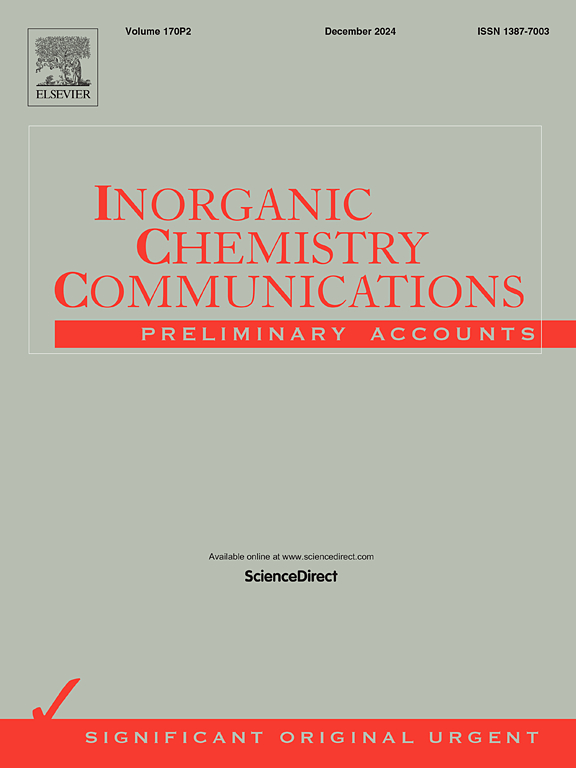Rational design and synthesis of orange emissive Ir(III) complexes Bearing Coumarin 6 and Imidazo-Diazaphene for Solution-Processed OLEDs
IF 4.4
3区 化学
Q1 CHEMISTRY, INORGANIC & NUCLEAR
引用次数: 0
Abstract
Organic light emitting diodes (OLEDs) have found extensive application in solid-state lighting and display technologies owing to their advantages of high energy efficiency, environmental friendliness, lightweight design, and flexibility. The phosphorescent iridium(III) complexes are widely used in the emissive layer of OLEDs due to their wide range of emission colors, short phosphorescent lifetime, and good photostability. Currently, the majority of OLEDs utilizing iridium(III) complexes are fabricated through the vacuum thermal evaporation technique. In contrast, this solution method offers the advantages of simplified preparation and minimal material consumption. In this paper, coumarin 6 was selected as the main ligand owing to its advantages of simple synthesis, high yield, and excellent luminescence stability. Two ionic phosphorescent iridium(III) complexes (Ir-TPIP/Ir-TPHIP) were synthesized by introducing triphenylamine moiety into imidazo[4,5-f][1,10]o-diazaphene and accessing a hexane chain at the imidazole as the two auxiliary ligands, respectively, both Ir-TPIP and Ir-TPHIP exhibit orange light with the maximum emission wavelengths of 564 and 585 nm in solution, respectively. Subsequently, Ir-TPIP/Ir-TPHIP-based orange OLEDs were prepared by the solution method, and the maximum brightness of the devices were 3038/1045cd/m2, with corresponding maximum CEs, PEs, and EQEs values of 4.13/4.45 cd/A, 0.79/0.87 lm/W and 1.81/1.87 %, respectively.

溶液处理oled中含香豆素6和咪唑-重氮芬的橙色发光Ir(III)配合物的合理设计与合成
有机发光二极管(oled)由于其高能效、环保、轻量化和灵活性等优点,在固态照明和显示技术中得到了广泛的应用。磷光铱(III)配合物因其发光颜色范围广、磷光寿命短、光稳定性好而广泛应用于oled的发射层。目前,大多数利用铱(III)配合物的oled都是通过真空热蒸发技术制备的。相比之下,该溶液法具有制备简化和材料消耗最小的优点。由于香豆素6合成简单、产率高、发光稳定性好等优点,本文选择香豆素6作为主要配体。将三苯胺部分引入咪唑[4,5-f][1,10]邻二氮杂苯中,并在咪唑上接入己烷链作为辅助配体,分别合成了两种离子磷光铱(III)配合物Ir-TPIP/Ir-TPHIP, Ir-TPIP和Ir-TPHIP在溶液中均呈现橙色光,最大发射波长分别为564 nm和585 nm。随后,采用溶液法制备了Ir-TPIP/ ir - tphip基橙色oled,器件最大亮度为3038/1045cd/m2,最大ce值为4.13/4.45 cd/A,最大pe值为0.79/0.87 lm/W,最大EQEs值为1.81/ 1.87%。
本文章由计算机程序翻译,如有差异,请以英文原文为准。
求助全文
约1分钟内获得全文
求助全文
来源期刊

Inorganic Chemistry Communications
化学-无机化学与核化学
CiteScore
5.50
自引率
7.90%
发文量
1013
审稿时长
53 days
期刊介绍:
Launched in January 1998, Inorganic Chemistry Communications is an international journal dedicated to the rapid publication of short communications in the major areas of inorganic, organometallic and supramolecular chemistry. Topics include synthetic and reaction chemistry, kinetics and mechanisms of reactions, bioinorganic chemistry, photochemistry and the use of metal and organometallic compounds in stoichiometric and catalytic synthesis or organic compounds.
 求助内容:
求助内容: 应助结果提醒方式:
应助结果提醒方式:


